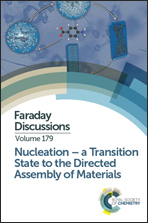New in situ solid-state NMR techniques for probing the evolution of crystallization processes: pre-nucleation, nucleation and growth
Abstract
The application of in situ techniques for investigating crystallization processes promises to yield significant new insights into fundamental aspects of crystallization science. With this motivation, we recently developed a new in situ solid-state NMR technique that exploits the ability of NMR to selectively detect the solid phase in heterogeneous solid–liquid systems (of the type that exist during crystallization from solution), with the liquid phase “invisible” to the measurement. As a consequence, the technique allows the first solid particles produced during crystallization to be observed and identified, and allows the evolution of different solid phases (e.g., polymorphs) present during the crystallization process to be monitored as a function of time. This in situ solid-state NMR strategy has been demonstrated to be a powerful approach for establishing the sequence of solid phases produced during crystallization and for the discovery of new polymorphs. The most recent advance of the in situ NMR methodology has been the development of a strategy (named “CLASSIC NMR”) that allows both solid-state NMR and liquid-state NMR spectra to be measured (essentially simultaneously) during the crystallization process, yielding information on the complementary changes that occur in both the solid and liquid phases as a function of time. In this article, we present new results that highlight the application of our in situ NMR techniques to successfully unravel different aspects of crystallization processes, focusing on: (i) the application of a CLASSIC NMR approach to monitor competitive inclusion processes in solid urea inclusion compounds, (ii) exploiting liquid-state NMR to gain insights into co-crystal formation between benzoic acid and pentafluorobenzoic acid, and (iii) applications of in situ solid-state NMR for the discovery of new solid forms of trimethylphosphine oxide and L-phenylalanine. Finally, the article discusses a number of important fundamental issues relating to practical aspects, the interpretation of results and the future scope of these techniques, including: (i) an assessment of the smallest size of solid particle that can be detected in in situ solid-state NMR studies of crystallization, (ii) an appraisal of whether the rapid sample spinning required by the NMR measurement technique may actually influence or perturb the crystallization behaviour, and (iii) a discussion of factors that influence the sensitivity and time-resolution of in situ solid-state NMR experiments.
- This article is part of the themed collection: Nucleation – a Transition State to the Directed Assembly of Materials

 Please wait while we load your content...
Please wait while we load your content...